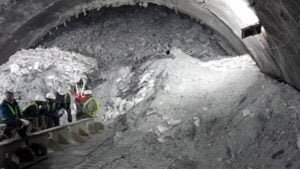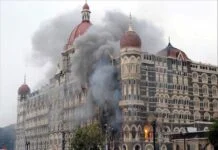Silkyara-Barkot tunnel under construction
With no significant advancements since Friday afternoon in the ongoing rescue operation to free 41 workers trapped inside the Silkyara-Barkot tunnel under construction, rescue teams and authorities are considering alternative strategies. One of the options being explored involves drilling a vertical tunnel from the mountaintop to access the trapped workers.
This consideration arises after a high-capacity drilling machine, brought in from Delhi, failed to penetrate beyond the 22-meter mark. The workers have been stuck behind over 50 meters of debris since 5:30 am on Sunday. Numerous methods have been attempted to rescue them, including using large excavators to clear the rubble and attempting to drill through the debris to insert pipes for the workers to crawl through.
Initially, machines from both Dehradun and Delhi were employed for this purpose. However, the “horizontal dry drilling equipment with an auger,” an American-made machine flown in from the national capital, faced complications as it repeatedly lifted off the ground upon reaching the 22-meter mark, damaging its bearings.
Despite an additional machine delivered by the Air Force to Jolly Grant Airport and subsequently transported to the site on Saturday morning, it remained unused by evening. According to a report on the rescue operation, at approximately 2:45 pm on Friday, a loud cracking sound was heard by the team working inside the tunnel, leading to panic among them.
Subsequent analysis suggested the possibility of a further collapse occurring in a section of the tunnel between 150 meters and 203 meters from the Silkyara side. The trapped workers are located beyond the debris, which spans between 205 meters and 260 meters inside the tunnel.
Throughout the day, several officials, including Mahmood Ahmed from the Ministry of Road Transport and Highways, Bhaskar Khulbe, former Advisor to the Prime Minister and Officer on Special Duty for Tourism, Mangesh Ghildiyal from the PMO Deputy Secretary’s office, along with Engineering Geologist Varun Adhikari and Expert Engineer Armando Capellan, reached the site to explore additional options.
Khulbe mentioned, “We are considering various possibilities to expedite reaching those trapped inside. We’ve assessed vertical, lateral, and incline options, seeking suggestions from experts to determine where and how to commence operations and estimate the timeframe.” “Four distinct locations—one from each side of the mountain and one vertical—have been selected for continued study.
Our aim is to work simultaneously on these options, independently progressing without concerning ourselves with other agencies’ actions,” Khulbe added, emphasizing the need to deliberate on the risks associated with vertical or lateral drilling. Arnold Dix, president of the International Tunnelling and Underground Space Association, also expressed his intention to contribute expertise to the rescue efforts.
“We’re leveraging our international expertise to assist India,” Dix stated. Varun Adhikari, an engineering geologist present at the site, mentioned that they are exploring all feasible options, with geologists from relevant organizations present to offer insights. “We’ll evaluate their input to determine viable possibilities.
Our considerations encompass vertical drilling from the mountaintop, drilling through the debris, and drilling from the opposite side of the tunnel (Barkot). We’re exploring all available avenues, with teams from Rail Vikas Nigam Limited, Satluj Jal Vidyut Nigam, National Highways & Infrastructure Development Corporation Ltd, and the involvement of the Oil and Natural Gas Corporation,” Adhikari explained.
After CEO Sam Altman’s dismissal, three top researchers resigned, worsening OpenAI’s






